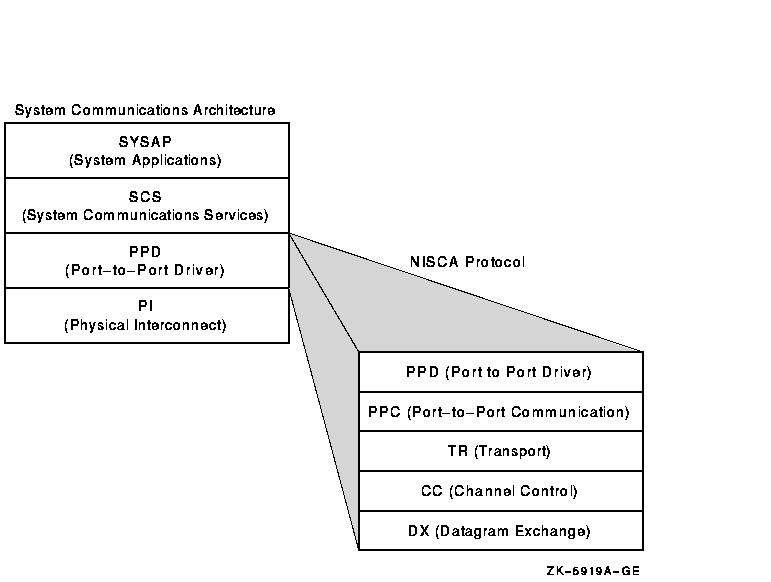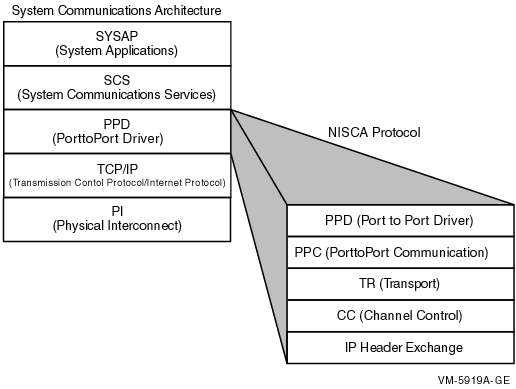| Previous | Contents | Index |
SYS$LAVC_DEFINE_NET_PATH can return the error condition codes shown in the following table.
| Condition Code | Description |
|---|---|
| SS$_ACCVIO |
This status value can be returned under the following conditions:
|
| SS$_DEVACTIVE | Analysis already running. You must stop the analysis by calling the SYS$LAVC_DISABLE_ANALYSIS function before defining the network components and the network component lists. |
| SS$_INSFARG | Not enough arguments supplied. |
| SS$_INVCOMPID | Invalid network component ID specified in the buffer. The bad_component_id address contains the failed component ID. |
| SS$_INVCOMPLIST |
This status value can be returned under the following conditions:
|
| SS$_IVBUFLEN | Length of the network component ID buffer is less than 16, is not a multiple of 4, or is greater than 508. |
| SS$_RMTPATH | Network path is not associated with the local node. This status is returned only to indicate whether this path was needed for network failure analysis on the local node. |
The SYS$LAVC_ENABLE_ANALYSIS subroutine starts the network component failure analysis.
Example: The following is an example of using the SYS$LAVC_ENABLE_ANALYSIS subroutine:
STATUS = SYS$LAVC_ENABLE_ANALYSIS ( ) |
This subroutine attempts to enable the network component failure analysis code. The attempt will succeed if at least one component list is defined.
SYS$LAVC_ENABLE_ANALYSIS returns a status in register R0.
E.6.2 Error Messages
SYS$LAVC_ENABLE_ANALYSIS can return the error condition codes shown in the following table.
| Condition Code | Description |
|---|---|
| SS$_DEVOFFLINE | PEDRIVER is not properly initialized. ROOT or PORT block is not available. |
| SS$_NOCOMPLSTS | No network connection lists exist. Network analysis is not possible. |
| SS$_WASSET | Network component analysis is already running. |
E.7 Stopping Network Component Failure Analysis
The SYS$LAVC_DISABLE_ANALYSIS subroutine stops the network component
failure analysis.
Example: The following is an example of using SYS$LAVC_DISABLE_ANALYSIS:
STATUS = SYS$LAVC_DISABLE_ANALYSIS ( ) |
This subroutine disables the network component failure analysis code
and, if analysis was enabled, deletes all the network component
definitions and network component list data structures from nonpaged
pool.
E.7.1 Status
SYS$LAVC_DISABLE_ANALYSIS returns a status in register R0.
E.7.2 Error Messages
SYS$LAVC_DISABLE_ANALYSIS can return the error condition codes shown in the following table.
| Condition Code | Description |
|---|---|
| SS$_DEVOFFLINE | PEDRIVER is not properly initialized. ROOT or PORT block is not available. |
| SS$_WASCLR | Network component analysis already stopped. |
NISCA is the transport protocol responsible for carrying messages, such as disk I/Os and lock messages, across Ethernet LANs to other nodes in the cluster. The acronym NISCA refers to the protocol that implements an Ethernet network interconnect (NI) according to the System Communications Architecture (SCA).
Using the NISCA protocol, an OpenVMS software interface emulates the CI port interface, that is, the software interface is identical to that of the CI bus, except that data is transferred over a LAN or IP network. The NISCA protocol allows OpenVMS Cluster communication over the LAN or IP network without the need for any special hardware.
This appendix describes the NISCA transport protocol and provides troubleshooting strategies to help a network manager pinpoint network-related problems. Because troubleshooting hard component failures in the LAN is best accomplished using a LAN analyzer, this appendix also describes the features and setup of a LAN analysis tool.
Additional troubleshooting information specific to the revised PEDRIVER is planned for the next revision of this manual. |
The NISCA protocol is an implementation of the Port-to-Port Driver
(PPD) protocol of the SCA.
F.1.1 SCA Protocols
As described in Chapter 2, the SCA is a software architecture that provides efficient communication services to low-level distributed applications (for example, device drivers, file services, network managers).
The SCA specifies a number of protocols for OpenVMS Cluster systems, including System Applications (SYSAP), System Communications Services (SCS), the Port-to-Port Driver (PPD), and the Physical Interconnect (PI) of the device driver and LAN adapter. Figure F-1 shows these protocols as interdependent levels that make up the SCA architecture. Figure F-1 shows the NISCA protocol as a particular implementation of the PPD layer of the SCA architecture.
Figure F-1 Protocols in the SCA Architecture

Table F-1 describes the levels of the SCA protocol shown in Figure F-1.
| Protocol | Description | ||||||||||||||||||||||||
|---|---|---|---|---|---|---|---|---|---|---|---|---|---|---|---|---|---|---|---|---|---|---|---|---|---|
| SYSAP | Represents clusterwide system applications that execute on each node. These system applications share communication paths in order to send messages between nodes. Examples of system applications are disk class drivers (such as DUDRIVER), the MSCP server, and the connection manager. | ||||||||||||||||||||||||
| SCS | Manages connections around the OpenVMS Cluster and multiplexes messages between system applications over a common transport called a virtual circuit (see Section F.1.2). The SCS layer also notifies individual system applications when a connection fails so that they can respond appropriately. For example, an SCS notification might trigger DUDRIVER to fail over a disk, trigger a cluster state transition, or notify the connection manager to start timing reconnect (RECNXINTERVAL) intervals. | ||||||||||||||||||||||||
| PPD |
Provides a message delivery service to other nodes in the OpenVMS
Cluster system.
|
||||||||||||||||||||||||
| PI | Provides connections to LAN devices. PI represents LAN drivers and adapters over which packets are sent and received. | ||||||||||||||||||||||||
Figure F-2 shows the NISCA protocol as a particular implementation of the TCP/IP layer of the SCA architecture.
Figure F-2 Protocols in the SCA Architecture for Cluster over IP

Table F-2 describes the levels of the SCA protocol shown in Figure F-2.
| Protocol | Description | ||||||||||||||||||||||||
|---|---|---|---|---|---|---|---|---|---|---|---|---|---|---|---|---|---|---|---|---|---|---|---|---|---|
| SYSAP | Represents clusterwide system applications that execute on each node. These system applications share communication paths in order to send messages between nodes. Examples of system applications are disk class drivers (such as DUDRIVER), the MSCP server, and the connection manager. | ||||||||||||||||||||||||
| SCS | Manages connections around the OpenVMS Cluster and multiplexes messages between system applications over a common transport called a virtual circuit (see Section F.1.2). The SCS layer also notifies individual system applications when a connection fails so that they can respond appropriately. For example, an SCS notification might trigger DUDRIVER to fail over a disk, trigger a cluster state transition, or notify the connection manager to start timing reconnect (RECNXINTERVAL) intervals. | ||||||||||||||||||||||||
| PPD |
Provides a message delivery service to other nodes in the OpenVMS
Cluster system.
|
||||||||||||||||||||||||
| TCP/IP | Cluster over IP uses UDP for cluster communication | ||||||||||||||||||||||||
| PI | Provides connections to LAN devices. PI represents LAN drivers and adapters over which packets are sent and received. | ||||||||||||||||||||||||
F.1.2 Paths Used for Communication
The NISCA protocol controls communications over the paths described in
Table F-3.
| Path | Description |
|---|---|
| Virtual circuit |
A common transport that provides reliable port-to-port communication
between OpenVMS Cluster nodes in order to:
The virtual circuit descriptor table in each port indicates the status of it's port-to-port circuits. After a virtual circuit is formed between two ports, communication can be established between SYSAPs in the nodes. |
| Channel | A logical communication path between two LAN adapters located on different nodes. Channels between nodes are determined by the pairs of adapters and the connecting network. For example, two nodes, each having two adapters, could establish four channels. The messages carried by a particular virtual circuit can be sent over any of the channels connecting the two nodes. |
Note: The difference between a channel and a virtual
circuit is that channels provide a path for datagram service. Virtual
circuits, layered on channels, provide an error-free path between
nodes. Multiple channels can exist between nodes in an OpenVMS Cluster
but only one virtual circuit can exist between any two nodes at a time.
F.1.3 PEDRIVER
The port emulator driver, PEDRIVER, implements the NISCA protocol and establishes and controls channels for communication between local and remote LAN ports.
PEDRIVER implements a packet delivery service (at the TR level of the NISCA protocol) that guarantees the sequential delivery of messages. The messages carried by a particular virtual circuit can be sent over any of the channels connecting two nodes. The choice of channel is determined by the sender (PEDRIVER) of the message. Because a node sending a message can choose any channel, PEDRIVER, as a receiver, must be prepared to receive messages over any channel.
At any point in time, the TR level uses single "preferred channel" to carry the traffic for a particular virtual circuit.
Starting with OpenVMS Version 8.3, the PEDRIVER also supports the following features:
Data compression can be used to reduce the time to transfer data between two OpenVMS nodes when the LAN speed between them is limiting the data transfer rate, and there is idle CPU capacity available. For example, it may be used to reduce shadow copy times, or improve MSCP serving performance between Disaster Tolerant cluster sites connected by relatively low-speed links, such as E3 or DS3, FDDI, or 100Mb Ethernet. PEdriver data compression can be enabled by using SCACP, Availability Manager, or the NISCS_PORT_SERV sysgen parameter.
The number of packets in flight between nodes needs to increase proportionally to both the speed of LAN links and the inter-node distance. Historically, PEdriver had fixed transmit and receive windows (buffering capacity) of 31 outstanding packets. Beginning with OpenVMS Version 8.3, PEdriver now automatically selects transmit and receive window sizes (sometimes called pipe quota by other network protocols) based on the speed of the current set of local and remote LAN adapters being used for cluster communications between nodes. Additionally, SCACP and Availability Manager now provide management override of the automatically-selected window sizes.
For more information, see the SCACP utility chapter, and NISCS_PORT_SERV in the HP OpenVMS System Management Utilities Reference Manual and the HP OpenVMS Availability Manager User's Guide.
Reference: See Appendix G for more information about how transmit channels are selected.
| Previous | Next | Contents | Index |